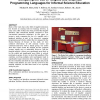595 search results - page 44 / 119 » Little languages: little maintenance |
CHI
2009
ACM
14 years 9 months ago
2009
ACM
Much of the work done in the field of tangible interaction has focused on creating tools for learning; however, in many cases, little evidence has been provided that tangible inte...
COGSCI
2004
13 years 9 months ago
2004
Disfluencies include editing terms such as uh and um as well as repeats and revisions. Little is known about how disfluencies are processed, and there has been next to no research...
PLDI
2009
ACM
14 years 9 months ago
2009
ACM
Class sharing is a new language mechanism for building extensible software systems. Recent work has separately explored two different kinds of extensibility: first, family inherit...
VL
2008
IEEE
14 years 3 months ago
2008
IEEE
Although a new class of languages has emerged to enable end users to create their own web applications, little is known about how end-user programmers actually use such languages ...
AOSD
2006
ACM
14 years 3 months ago
2006
ACM
The relationships between objects in object-oriented programs are as important as the objects themselves. Unfortunately, most objectoriented programming languages provide little s...

